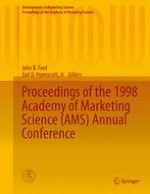2015 | OriginalPaper | Buchkapitel
Predicting Response Inducer Effects in Organisational Respondents
verfasst von : Vince-Wayne Mitchell
Erschienen in: Proceedings of the 1998 Academy of Marketing Science (AMS) Annual Conference
Aktivieren Sie unsere intelligente Suche, um passende Fachinhalte oder Patente zu finden.
Wählen Sie Textabschnitte aus um mit Künstlicher Intelligenz passenden Patente zu finden. powered by
Markieren Sie Textabschnitte, um KI-gestützt weitere passende Inhalte zu finden. powered by
Theories of response behaviour imply an understanding of the target population which has hitherto been largely ignored by practitioners. Evidence suggests that response rates vary widely across industries (Mitchell & Critchlow, 1993; Tomaskovic-Devey et al., 1994) and there is a remarkable variation in the response increases documented for similar response inducers (Duncan, 1979; Houston & Ford, 1976; Kanuk & Berenson, 1975; Linksy, 1975; Harvey, 1987; Goyder, 1982; Heberlein & Baumgartner, 1978; Yu & Cooper, 1983; Fox, Crask & Kim, 1988; Y ammarino, Skinner & Childers, 1991). For example, social-utility appeals are more effective with consumers (Jones & Linda, 1978), whilst ego appeals are more effective with sales people (Tyagi, 1989). The increasing evidence suggests that to achieve maximum response to mail surveys response inducers need to be tailored to specific populations. Current response theories and frameworks have advanced our understanding and knowledge, but their links to documented and proven changes in survey methodology are weak. Gaining information about a population's attitudes and feelings towards these constructs is not easy to achieve, and even if achievable, the problem of deciding how these attitudes precisely affect response behaviour in general, and response to specific techniques in particular, still exists. What is required is a method of identifYing which response inducers will work best within a given population. The difficult, time-consuming and costly nature of experimental investigations of each response inducer's effect prompted a search for a less costly method of adapting methodologies in the form of using attitudinal data used in conjunction with experimental results. Apart from time and cost savings, attitude measurement allows assessment of response influencers which are difficult to vary experimentally, e.g. the mood of the respondent and whether the survey arrives at a busy time. A predictive attitudinal behavioural formula of response behaviour which covered 27 response inducement techniques was developed and tested.
